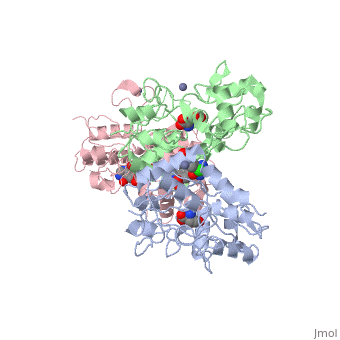3ik6
Crystal structure of the AMPA subunit GluR2 bound to the allosteric modulator, chlorothiazideCrystal structure of the AMPA subunit GluR2 bound to the allosteric modulator, chlorothiazide
Structural highlights
FunctionGRIA2_RAT Receptor for glutamate that functions as ligand-gated ion channel in the central nervous system and plays an important role in excitatory synaptic transmission. L-glutamate acts as an excitatory neurotransmitter at many synapses in the central nervous system. Binding of the excitatory neurotransmitter L-glutamate induces a conformation change, leading to the opening of the cation channel, and thereby converts the chemical signal to an electrical impulse. The receptor then desensitizes rapidly and enters a transient inactive state, characterized by the presence of bound agonist. In the presence of CACNG4 or CACNG7 or CACNG8, shows resensitization which is characterized by a delayed accumulation of current flux upon continued application of glutamate.[1] [2] [3] [4] [5] [6] [7] [8] [9] [10] [11] [12] [13] [14] Evolutionary ConservationCheck, as determined by ConSurfDB. You may read the explanation of the method and the full data available from ConSurf. Publication Abstract from PubMedIonotropic glutamate receptors mediate the majority of vertebrate excitatory synaptic transmission and are therapeutic targets for cognitive enhancement and treatment of schizophrenia. The binding domains of these tetrameric receptors consist of two dimers, and the dissociation of the dimer interface of the ligand-binding domain leads to desensitization in the continued presence of agonist. Positive allosteric modulators act by strengthening the dimer interface and reducing the level of desensitization, thereby increasing steady-state activation. Removing the desensitized state for simplified analysis of receptor activation is commonly achieved using cyclothiazide (CTZ), the most potent modulator of the benzothiadiazide class, with the flip form of the AMPA receptor subtype. IDRA-21, the first benzothiadiazide to have an effect in behavioral tests, is an important lead compound in clinical trials for cognitive enhancement as it can cross the blood-brain barrier. Intermediate structures between CTZ and IDRA-21 show reduced potency, suggesting that these two compounds have different contact points associated with binding. To understand how benzothiadiazides bind to the pocket bridging the dimer interface, we generated a series of crystal structures of the GluR2 ligand-binding domain complexed with benzothiadiazide derivatives (IDRA-21, hydroflumethiazide, hydrochlorothiazide, chlorothiazide, trichlormethiazide, and althiazide) for comparison with an existing structure for cyclothiazide. The structures detail how changes in the substituents at the 3- and 7-positions of the hydrobenzothiadiazide ring shift the orientation of the drug in the binding site and, in some cases, change the stoichiometry of binding. All derivatives maintain a hydrogen bond with the Ser754 hydroxyl, affirming the partial selectivity of the benzothiadiazides for the flip form of AMPA receptors. Probing the allosteric modulator binding site of GluR2 with thiazide derivatives.,Ptak CP, Ahmed AH, Oswald RE Biochemistry. 2009 Sep 15;48(36):8594-602. PMID:19673491[15] From MEDLINE®/PubMed®, a database of the U.S. National Library of Medicine. See AlsoReferences
|
| ||||||||||||||||||
